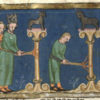Iconoclasm is a very old spiritual and philosophical paradox. On the one hand it differs from atheism in that it does not deny the reality of truth or God, but it challenges codification of these ideas. It is on its face an opposition to any representation of the divine images, and on another it’s a desire to move closer to a true understanding of any idea that orthodox institutions offer. In a sense, it shares a spirit with anarchism in that no representational codification of the divine is truly seen as adequate, and allows for no adherence to a fixed image.
In common with Heresy as well? Heresy is a dissenting interpretation of conventional dogmas. Iconoclasm is levelling these dogmas to their very bedrock, and then perhaps after, engaging in speculation regarding a more true interpretation.
Heresy is opposition vs. Iconoclasm going to source and bypassing the dogma? Heresy is disagreement, if only by matter of degree. Iconoclasm would be closer to an oppositional stance, but still without a necessarily destructive stance. Iconoclasm can be taken up more from the attitude of a devil’s advocate, even if you hold to no commitment to the abolishment of an institutionalized image or concept.
Perhaps of interest, Iconoclasm has almost as a rule been taken up not by opponents of a belief in total, but more as a tool for sectarian rectification motivated by a refusal to use or reuse old ideas.
Trying to purify a belief so to speak? Break down dogma in the way of Christ’s message for example? Yes. One example of that is the Nestorian schism, where the literal person of Christ is seen as dual in nature as opposed to the more mosaic literal identification.
Would Jesus be considered an Iconoclast? Basically, yes. He spoke with the intent of clarifying the spirit of Jewish law, as well as questioning the established Rabbinical authority. He felt they were not sincere in trying to keep the way that was revealed to them.
Elaborate on the schism you mentioned, dual vs. mosaic? In the Nestorian heresy if you will, they taught that the human named Jesus was of a dual nature. Both a normal human man and the vessel of the logos which is the word/will of God. They felt that the idea of God as subject to human failings was dubious, but that if you accepted Christ’s dual nature then both roles could be present in the same being. So the use of Jesus as a literal representation/embodiment of God was not adhered to by the Nestorians.
So Monism is related to Iconoclasm? Monism is related to Iconoclasm in that they would be opposed.
Your thoughts are welcome. Be well friends.
Travis Saunders
Dragon Intuitive
~science,mysticism,spirituality~



Leave a Reply